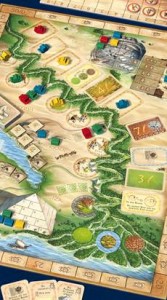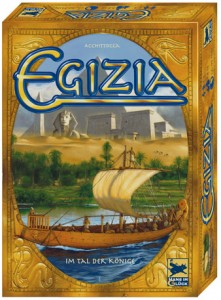Review: Egizia
Posted by James (admin) on July 27th, 2010
 Egizia was a game on my list to check out at Essen in 2009. I would even have taken a punt and bought it without playing it first but the text on the cards was in German. So, I played it soon as I had a chance a couple of weeks ago when the English language version was released.
Egizia was a game on my list to check out at Essen in 2009. I would even have taken a punt and bought it without playing it first but the text on the cards was in German. So, I played it soon as I had a chance a couple of weeks ago when the English language version was released.
Set in Ancient Egypt, players try to gain as many victory points (VPs) as possible over 5 rounds. Each player has 8 ships and, in turn order (the player with fewest VPs goes first), players place their ships one at a time on spaces along the Nile following two important rules: first, only one ship can be placed on each space and, second, a player can not place a new ship upstream of any of their ships that they have already placed.
There are two main types of spaces along the Nile. On one side are fixed spaces that offer the same benefits every round (improving construction crews, changing the weather and improving the player’s stone/grain markets – all explained later) plus there are 3 sets of building spaces where the player needs to have a ship if they want an opportunity to build monuments later in the round. On the other side of the Nile, there are spaces whose benefits are determined by cards placed on each space at the start of each round (which increase as the game progresses). The cards offer benefits that can be permanent, immediate use, or held for later use. These benefits range from the simple (extra quarries or fields, one-off food bonuses, temporary construction crew strength boosts, bonus VPs, etc.) to more unusual abilities (place a ship on a space already occupied by another player, place two ships in a row, keep 2 Sphinx cards (explained later), take an unclaimed card at the end of the round, etc.)
When no player is able to place any further ships, players must feed their construction crews. The amount of food required is equal to the total strength of their four construction crews (starting at 1 or 2 with a maximum of 9 each). If a player can not feed their crews, they lose 1 to 3 VPs for each food they are short. The exact amount is determined by where the player’s marker is on the grain market (explained later). So, players need to balance the strength of their construction crews with their food production. Players start with a field that can produce 6 food but can obtain other fields (and food bonuses) from the spaces. However, some fields only produce food in certain weather conditions and the players have a chance to change the weather when placing ships – so players can try to ensure their fields produce food, or even ensure other players’ fields do not produce food. Note that unused food can not be carried over to the next round. After feeding, players gain stone from their quarries (each player starts with a quarry that produces 3 stone each round). Stone is used for building (unused stone carries over to the next round). Next, building takes place.
Along the Nile are three building locations (the Sphinx, obelisks/graves, and pyramid/temple) and each location has 3 spaces for ships (players build at each location in the order in which their ships were placed). Any building action requires a specific amount of construction crew strength and an equal amount of stone to match. Each time a player builds, they can only use ONE construction crew (plus their bonus construction crew too if they want) and each crew can only used once each round. So, players must manage which crew which will do which building action (if any) and balance having enough crew with enough stone (as workers without stone are no use, and vice versa). Each building location has different rules and benefits:
The Sphinx – This is a way to earn instant VPs plus get hidden objectives that can earn extra VPs at the end of the gane. The player takes a number of Sphinx cards equal to the total construction strength (paying one stone for each) up to a maximum of 5 cards. The player keeps a maximum of 1 card and score 1s VP for each card returned to the deck. A few Sphinx card examples are: 7 VPs if the seventh level of the obelisk is built (by anyone), 8 VPs if the player has built at least 7 sections of the Pyramid, 7 VPs for having the most productive quarries, 1VP for each point of strength of a specific construction crew, 1 VP for each 10VPs earned, etc.
Obelisk/Graves – Built from the bottom level upwards, each section of the obelisk and each grave requires a specific amount of construction crew strength (plus one stone for each) to be spent to build them. When a player builds a section, they place one of their colour markers to show they built it, receive VPs and can develop their stone or grain market one step too. A player can build any mixture of part(s) of the obelisk and one or more graves. Each grave gives VPs but also players can score some bonus VPs if they build enough graves by the end of the game.
Pyramid/Temple – Built from the bottom level upwards, each section of the pyramid and temple requires a specific amount of construction crew strength (and an equal amount of stone) to be spent to build them. When a player builds a section, they place one of their colour markers to show they built it and receive VPs. If a whole row of the pyramid is completed, the player who build the most sections in that row scores bonus VPs too. A player can build any mixture of part(s) of the pyramid, the temple, or both.
There’s also a bonus for doing any building too (1VP for building at 1 location, 3VPs for building at 2 locations, and 6VPs for building at 3 locations). With all the building done, the turn order for the new round is determined, new cards are laid out along the Nile and the next round begins. After 5 rounds the game ends and players score the points for any Sphinx cards they have fulfilled.
Before I discuss my thoughts on Egizia, I just want to explain the grain and stone markets that I mentioned. Each player has a marker on each of these two tables which are printed on the board. The grain market determines how many VPs are lost for each food a player is short when feeding. If the player develops their grain market during the game, they move their marker down the table one step at a time and each step means they suffer lower VP loss if they can’t feed their crew. If the player develops their grain market to the last row (and every time after that), they get 2 VPs. The stone market is similar but only the last 2 rows offer benefits: on reaching the second to last row, a player can trade 2 stone for 1 VP at the end of the game, and on reaching the final row (and every time after that) the player gets 3 stone.
 Overall, I really enjoyed Egizia. In essence, it’s a worker (ship) placement game but feels like a lot more than that because there are multiple things to balance and many ways to score VPs. Placement is interesting because not only are you trying to secure spaces before your opponents grab them, but not being able to place upstream of your own pieces means each player is looking slightly differently at the board too. You can grab a space you really want downstream but at the expense of committing to never using those before it.
Overall, I really enjoyed Egizia. In essence, it’s a worker (ship) placement game but feels like a lot more than that because there are multiple things to balance and many ways to score VPs. Placement is interesting because not only are you trying to secure spaces before your opponents grab them, but not being able to place upstream of your own pieces means each player is looking slightly differently at the board too. You can grab a space you really want downstream but at the expense of committing to never using those before it.
Having lots of things to balance – stone, food, crew development, market development – was very entertaining giving lots of think about without being too difficult or complex. What I really liked was that you didn’t need to have a completely balanced approach to do well either so you could play it your own way (or with what you were able to get) so long as you use your position intelligently to maximise score VPs. Also, you feel you always have the opportunity to grab other resources (although it may be at a price).
It’s imporant to point out that Egizia is not a complex game – it may be a long description above but that’s because Egizia has lots of simple interesting choices and variety. In fact, variety is the important part here – there are lots of ways to score VPs- building sections of monuments (plus bonuses), Sphinx cards, instant VPs from Nile cards, grain market, stone at the end of the game, and few more – but there is a variety of resource mixtures that work well. In addition, the game is different every time due to the cards used for the Nile spaces.
Player interaction is high because of the competition over the spaces (sometimes just to deny others), but there’s also interaction when choosing what to build (before the next player has a chance to do so) and affecting the weather can really help or hinder players.
On the negative side, I felt just a few of the cards seemed a lot more powerful than the others. Now we know which these are, the competition for these will be much greater. Also, the rules a bit convoluted, especially the building section – one rule about building the pyramid is only mentioned in an example and not in the main body of the rules. Still, it didn’t take too long to work it out.
We played with the full 4 players and I believe the game will play slightly differently, and just as well,with fewer players. Either way, I’m looking forwards to playing Egizia again.
James.
[Played with 4 players]

